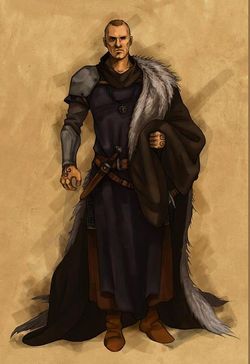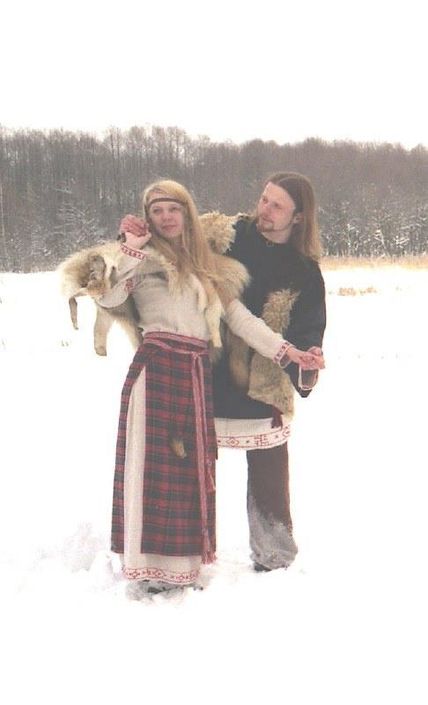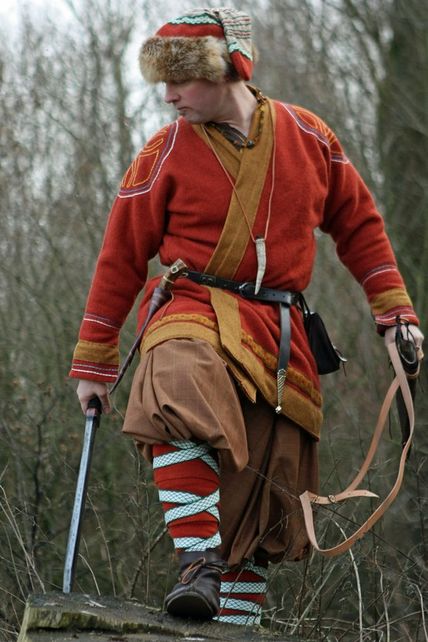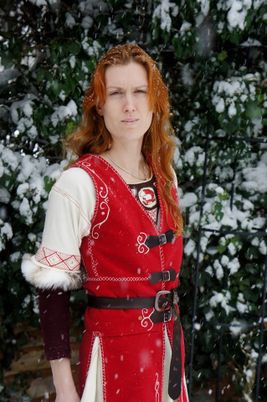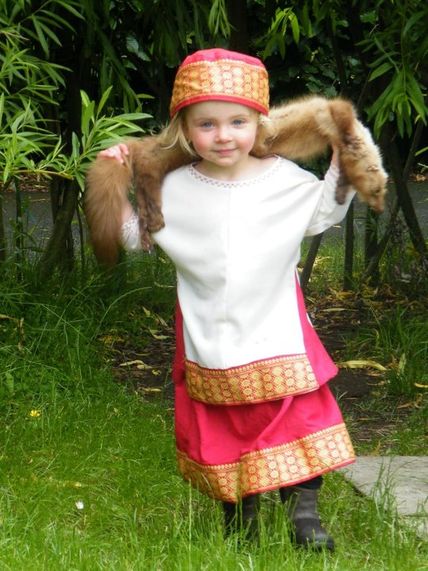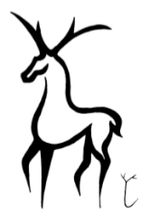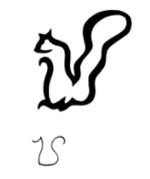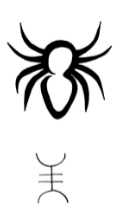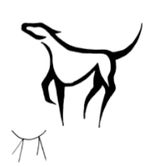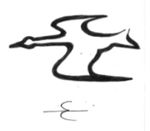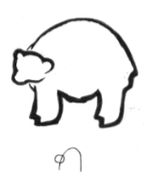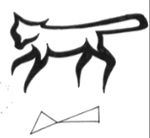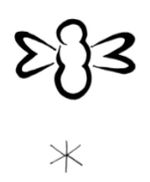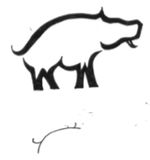Varushka look and feel
Overview
Varushkans like to display their wealth in their costume. Clothes are usually practical and well made but are made from cloth dyed in bright colours and then intricately embroidered with a dark thread. The use of fur is common, on cloaks, robes and mantles in a range of colours and styles.
Armour and weapons are always solid and well made. For most they are practical pieces made to serve, but the wealthiest Varushkans use ornate designs that serve to strike fear into their enemies. Talismans are widespread, used to help ward off evil.
Also see Varushka costumes and Varushka icons and artistry.
Feel
Dour, stern, uncompromising, wise, cunning, prosperous, rich, powerful.
Breakdown
Influences
Rus and Slavic costume.
Materials
Fabrics are usually a single colour, suitable for embroidery or decoration. Poorer Varushkans use practical and hard wearing materials like wool, felt, heavy cotton, leather - but the fabric is less important than the decoration. Fur is common, but is usually reserved for trim.
Colours
Bright vibrant colours predominate. A white shirt or dress is the most common under garment, with brightly decorated hems. Garments are made from cloth of a single colour, with contrasting colours being used for decoration and under garmets.
Clothing
The base layer is usually a white shirt or dress, with embroidered hems. Poor Varushkans use wool to stay warm, but most prefer to wear multiple layers of lighter clothing, often in contrasting colours. Warm shawls in bright colours are handed down through families.
Trousers for men and women have baggy legs that fall just above or below the knee with stockings bound to the leg beneath them. Women’s dresses have full, layered skirts and aprons.
Coats are more common than cloaks. The ideal coat has an asymmetric overlap across the chest, is nipped in at the waist but flares out below the waist to a full ‘skirt’. The wealthiest wear coats in bright strong colours often with fur trim or embroidered hems.
Decoration
Fur is used extensively to trim garments of all kinds including armour. Garmets are not made from decorative cloth or covered entirely in decoration, rather it is put in bands usually around the upper arms and the hems. Complex and detailed embroidery is the favourite, most commonly in brilliant red for a white garment. Smocking is common.
Jewellery
Amber and silver are most commonly worn. Hunters carry amulets, talismans and fetishes designed to protect them from the monsters that might otherwise hunt them in turn.
Armour
The most common armour is scale or lamellar, either leather or metal. Splinted greaves and vambraces are common. Helms usually rise to a point, often with a plume.
A few Boyars wear plate that has a simple design but is intricately decorated. Plate can be tooled to emphasize the strength and power of the wearer and to make them appear darker and more intimidating.
Shields
Round shields are common and some Schlacta employ a pavisse.
Weapons
Schlacta, the Varushkan professional warriors, use heavy weapons of war such as broad swords, war axes and bardiches. The woodsman’s axe is a common weapon for many other Varushkans.
Varushkan costume
Low status costume
This couple are wearing some traditional Varushkan garmets, a white dress and a white tunic with embroidered hems respectively. Sheepskin is a practical but cheap material which is worn by poor Varushkans, wealthier individuals would layer their garments and hem them with fur. Patterned fabrics, such as the woman’s skirt, are used by the poor in place of the embroidered garments worn by most Varushkans.
Trousers
Varushkan men and women wear plain coloured “hero trousers”. Ideally these should be baggy down to just past the knee. Anything worn below the knee should be strapped to the leg. Trousers may be plain or brightly dyed but are usually made from fabric of a single colour; the strapping is another opportunity for a bright contrasting colour, embroidery or both.
Varushkan armour
The traditional Varushkan armour worn by the Schlacta, the professional soldiers, is tightly woven scale or lammellar. Varushkan armour is as likely to be leather as metal. 
Varushkan helms
The ideal Varushkan helm is pointed with a plume emerging from the point. 

Boyars
Boyars who are warriors often wear the traditional lammellar armour but with more complete coverage and supplemented with hardened leather or plate on the fore-arms and legs. 
Boyars are not sadistic tyrants, but their rule may be authoritarian, callous or even cruel. Some adopt an intimidating demeanour, the better to project their power and authority over their dominion. Warrior boyars who choose to fight the monsters of the dark forests by appearing as dark as their foes may wear a suit of plate fashioned that reflects the dark gothic tone of the nation.
Embroidery
The most distinctive feature of Varushkan costume is the intricate embroidery that provides a stark contrast. Embroidery should stand out and show off the wearer’s wealth. The entire garment should not be embroidered or decorated - the ideal placements are hems and in bands around the upper arm, but any garment will look more Varushkan with some embroidery. 

Hats
Varushkan hats may be simple embroidered round caps trimmed with fur or else pointed caps that fold over the head.
Children
Costume for Varushkan children follows the traditional styles and emphasis on bright colours.
Animal Runes
Varushkans often use animal symbols and runes to express virtues in their storytelling and artwork.
Images to avoid
A LRP setting is defined as much by what you leave out as by what you include. In defining the Varushkan look we have actively chosen to exclude some elements. Please do not use any of the images or looks seen in this section.
Avoid: Hussars' jacket
Hussars are too modern for the game and the Hussars' jacket is not part of the Varushkan look. Varushkan wear full length coats not the short jackets favoured by cavalyrmen.
Please try to avoid frogging or tablet braiding across the chest that is so elaborate and intense that it evokes the Hussar image. Varushkan decoration is primarily embroidery and fur trim.
Avoid: Thor’s hammer
Thor’s Hammers have become as evocative and iconic as a crucifix. They are irrevocably associated with Thor, a deity which does not exist in the Empire game setting, so please avoid this specific piece of jewellery.
Avoid: Cossacks
The Varushkan look is inspired by Rus and Slavic costume and does not include Cossacks. We have excluded the Cossack look from the setting because like the Hussars it is evocative of a much later period than the game draws from. Please avoid elements that are reminiscent of cossacks; boots that rise to meet the trousers, small waistcoats, and cossack- style hats made entirely of fur.
Please also avoid cossack dancing. It is iconic - for Cossacks - but is not appropriate for Varushkans in Empire. 
